In today’s digital age, a well-defined online presence is no longer a luxury – it’s a necessity. Your company’s digital footprint, the trace of your brand’s activities across the web and social media, holds immense power when it comes to crafting effective marketing strategies. By understanding how customers interact with your brand online, you can gain valuable insights into their preferences and tailor your approach to drive engagement and ultimately, revenue growth.
Consider this: A whopping 84% base purchasing decisions on a company’s online reputation. This highlights the undeniable power your digital footprint holds in shaping brand perception and driving customer behavior. At Palowise, we stay ahead of the curve on digital footprint trends and statistics. We leverage this knowledge to empower you with the insights needed to optimize your online strategy. Unlocking significant growth potential for your brand is within reach.
What is Digital Footprint
Your digital footprint is the unique trail of data you create as you navigate the internet and digital world. It encompasses all the traceable online activity associated with you or your brand, shaping your online reputation and influencing how others perceive you.
Here’s a breakdown of the key elements that contribute to your digital footprint:
- Element #1: Actively Created Content: This refers to the information you directly share online, such as social media posts, blog comments, and online forum discussions.
- Element #2: Passively Collected Data: This is the data gathered about your online activity without your direct input. It can include browsing history, cookies placed on your device by websites, and location tracking.
Social media intelligence leverages this passively collected data to understand audience demographics, brand sentiment, and competitor analysis within the social media landscape.
Types of Digital Footprint:
- Passive Personally Identifiable Data: Information such as IP addresses and approximate locations that are tracked without the individual’s knowledge and can be linked back to their real identity.
- Passive Anonymous Data: Data generated anonymously or through the use of pseudonyms while browsing the internet or using VPNs to conceal one’s IP address.
- Active Personally Identifiable Data: Data willingly shared by individuals, such as social media posts and emails, which can be directly linked to their real identity.
- Active Anonymous Data: Information voluntarily shared online without revealing one’s true identity, often through the use of pseudonyms or anonymous profiles on social media platforms.
- User Input Data: Messages or information provided by users through mobile apps, which may contain personal details or identifiable information.
- Sensor Data: Information collected by sensors like cameras or microphones in public or private spaces, which may indirectly contribute to an individual’s digital footprint.
5 Digital Footprint Statistics for 2024
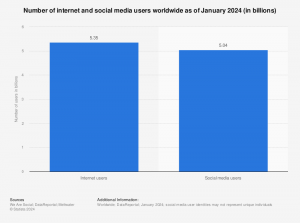
Source: Statista
Understanding the ever-evolving landscape of digital footprints is crucial for businesses to thrive online. Here are the 5 most important statistics to keep in mind for 2024, incorporating real numbers from reputable sources:
Statistic #1: Global Reach: As of January 2024, there are over 5.35 billion internet users worldwide, representing a staggering 66.2% of the population. This immense online audience means your brand’s digital footprint has the potential to connect with a wider audience than ever before.
Statistic #2: Social Media Influence: Social media is key for brand influence. A 2023 We Are Social report indicates that consumers who follow brands on social media are 78% more likely to recommend them to others. This emphasizes the importance of building a strong social media presence to connect and influence potential customers.
Statistic #3: Mobile Dominance: Mobile continues to dominate internet usage. A Statista report in March 2024 indicates that 61.21% of all website traffic now originates from mobile devices. This highlights the necessity for businesses to have a mobile-friendly website and social media strategy to cater to their mobile audience.
Statistic #4: Data Privacy Concerns: As data privacy becomes a growing concern, a 2023 Pew Research Center survey revealed that 79% of Americans are worried about the amount of data companies collect online. This emphasizes the importance of data transparency and building trust with your audience.
Statistic #5: Power of Online Reviews: Online reviews hold immense sway over consumers. A 2023 Power Reviews survey revealed that 90% of consumers say online reviews influence their purchasing decisions. This underlines the importance of managing your online reputation and encouraging positive customer reviews.
General Digital Footprint Statistics
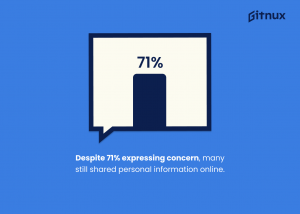
Source: Gitnux
Understanding the vast amount of data points that make up a digital footprint is crucial for both businesses and individuals. Here are some general digital footprint statistics to paint a broader picture:
Statistic #1: Data Creation Boom: The amount of data created online is exploding. According to IDC, by 2025, the global datasphere will reach a staggering 175 zettabytes. This highlights the ever-increasing volume of information that contributes to digital footprints.
Statistic #2: Social Sharing Habits: People are actively sharing information online. A 2023 Pew Research Center study revealed that 78% of American internet users have shared personal information online in the past year. This statistic emphasizes the importance of being mindful about what information you share publicly.
Statistic #3: Passive Data Collection: A significant portion of your digital footprint is data collected without your direct input. A report by Ghostery in 2023 estimated that the average website contains 32 tracking scripts, collecting data on user browsing behavior. This highlights the need for individuals to be aware of the data being collected about them online.
Statistic #4: Digital Footprint Persistence: Information online can be surprisingly persistent. A University of Washington study in 2022 found that 63% of deleted online content remains retrievable through various means. This emphasizes the importance of being cautious about what information you post online, as it may be difficult to erase completely.
Digital Carbon Footprint Statistics
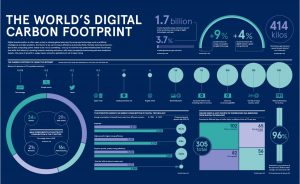
Source: Raconteur
The environmental impact of our digital lives is a growing concern. Here are some key statistics to understand the carbon footprint of the digital world:
Statistic #1: Global Impact: The digital sector’s energy consumption is significant. According to the International Energy Agency (IEA), information and communication technology (ICT) is responsible for roughly 7% of global electricity consumption. This highlights the environmental cost of powering the vast infrastructure that supports our digital activities.
Statistic #2: Emissions on the Rise: The carbon footprint of the digital world is increasing. A 2022 report on Sage Journals estimated that Information and Communication Technologies (ICT) contribute up to 4% of global greenhouse gas emissions. This percentage is expected to rise as internet usage and reliance on digital services continue to expand.
Statistic #3: Video Streaming’s Share: Streaming video content is a major contributor to the digital carbon footprint. A 2022 report by the Shift Project found that online video streaming accounts for an estimated 30% of global internet traffic. This translates to a significant share of the energy consumption and associated carbon emissions.
Statistic #4: E-waste Challenge: The growing amount of electronic waste (e-waste) adds to the environmental impact. According to the United Nations Environment Programme (UNEP), in 2022, the world generated 57.4 million metric tons of e-waste, with only a fraction being properly recycled. The production and disposal of electronic devices contribute to greenhouse gas emissions and resource depletion.
Statistic #5: The Expanding Footprint: The digital world’s carbon footprint is on the rise. The Global Carbon Project indicated that the ICT sector’s CO2 emissions reached 7.3% of global emissions in 2020. This percentage is projected to grow further as internet usage and reliance on digital services continue to expand. This statistic emphasizes the urgent need for solutions to mitigate the environmental impact of our digital activities.
Digital Footprint Statistics per region
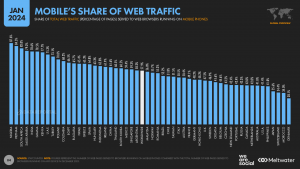
Source:DataReportal
Digital footprints can vary significantly by region due to several factors. These include:
-
Infrastructure and Internet Access: Developed nations with widespread high-speed internet access will naturally have larger digital footprints compared to regions with limited connectivity.
-
Digital Literacy and Online Habits: Areas with higher digital literacy and a culture of online engagement will see more active digital footprints compared to regions with lower internet adoption.
-
Government Regulations and Privacy Concerns: Regulations around data collection and privacy can influence the type and amount of data people share online, shaping the size and content of digital footprints.
Digital Footprint Statistics for Australia
Australia has a high level of internet penetration and digital adoption, leading to substantial digital footprints for its citizens. Here are some statistics to illustrate this:
Statistic #1: Widespread Internet Access: A January 2024 report by Statista indicates that the number of internet users in Australia was forecast to continuously increase between 2024 and 2029 by in total 1.2 million users (+4.59 percent). This widespread internet penetration contributes to significant digital footprints.
Statistic #2: Social Media Engagement: The Digital 2024 Australia Report indicates that 20.8 million Australians (78.3% of the population) are active social media users. This highlights a strong culture of online engagement, which contributes significantly to the content and size of digital footprints.
Digital Footprint Statistics for the USA
The United States exhibits a robust digital landscape with extensive user footprints. Here’s a glimpse:
Statistic #1: Widespread Connectivity: As of February 2024, Statista reports that roughly 98% of the US population has internet access. This widespread access lays the foundation for significant digital footprints.
Statistic #2: Mobile Internet Dominance: A January 2024 report by Statista on Mobile vs. Desktop Users Worldwide highlights that 63.5% of internet users globally access the internet primarily through mobile devices. While this report is global, data suggests a similar trend in the US, with a high proportion of internet users relying on mobile devices. This mobile-first approach significantly impacts the way people interact online, contributing to the dynamic nature of digital footprints in the US.
Statistic #3: Social Media Landscape: A 2024 Pew Research Center report on How Americans Use Social Media indicates that 78% of Americans use social media platforms. This active participation in online communities contributes significantly to the content and overall size of digital footprints in the US.
Digital Footprint Statistics for Europe
Europe exhibits a complex digital landscape with variations across countries. However, some general trends contribute to substantial digital footprints in the region. Here are a few examples:
Statistic #1: High Internet Penetration: A February 2024 update on household internet access by Eurostat, the statistical office of the European Union, indicates that over 90% of European households have internet access. This widespread connectivity serves as a foundation for extensive digital footprints.
Statistic #2: E-commerce Growth: According to a February 2024 report by Ecommerce Europe, a pan-European association for e-commerce, the European e-commerce market is expected to reach a value of €931 billion by 2024. This thriving online commerce landscape contributes significantly to the data trails and interactions that shape digital footprints.
Statistic #3: Social Media Landscape: A 2024 report by Kepios suggests that 77% of Europeans use social media platforms. This active online engagement contributes significantly to the content and overall size of digital footprints in Europe.
Statistic #4: Privacy-Conscious Users: A 2020 Eurobarometer survey by the European Commission indicates that 72% of Europeans are concerned about how companies use their online data. This privacy consciousness might lead to a focus on platforms with stronger privacy controls, potentially influencing the specific types of data forming European digital footprints.
Digital Footprint Statistics for Asia
Asia presents a diverse digital landscape with significant growth potential. Here are a couple of statistics to showcase the expanding digital footprint in the region:
Statistic #1: Rising Internet Penetration: A January 2024 report by DataReportal indicates that over 53% of Asia’s population has internet access. This growing connectivity lays the foundation for extensive digital footprints as internet usage becomes more widespread.
Statistic #2: Mobile-First Culture: According to a February 2024 report by GSMA , over 70% of mobile phone connections in Asia are on mobile broadband. This dominance of mobile internet access fosters a mobile-first approach, shaping the way users interact online and contribute to their digital footprints.
Digital Footprint Statistics per Age Group (Understand Your Audience)
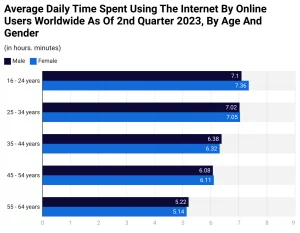
Source: Statista
The digital footprint of a person can vary significantly depending on their age group. Here’s a brief explanation:
-
Younger generations (Gen Z, Millennials): Grew up with the internet and technology, leading to a high level of comfort and engagement in the digital world. They tend to use a wider variety of online platforms and apps, including social media, gaming, and streaming services. Their digital footprint may be more dynamic and constantly evolving due to frequent online activity.
-
Older generations (Gen X, Baby Boomers): May have adopted the internet later in life and might be less comfortable with certain online activities. Their digital footprint might be more focused on email, news websites, and social media for basic communication. The content and size of their digital footprint may be less extensive compared to younger generations.
Digital Footprint Statistics for Generation Alpha (Born 2010 and after)
Statistic #1: Early Exposure: While pinpointing recent studies specifically on Gen Alpha’s internet usage can be difficult, a 2023 report by Exploding Topics suggests a rise in screen time for young children during the pandemic. 60% of American students have a school-provided device, and an additional 14% bring their own devices from home. This trend indicates a potential for early internet exposure within Gen Alpha.
Statistic #2: Focus on Visual Content: A 2021 report by Common Sense Media, a non-profit organization focused on children’s technology use, found that overall screen use among teens and tweens increased by 17 percent from 2019 to 2021. Their digital footprint might be influenced by educational apps and platforms like YouTube Kids that emphasize visual elements.
Digital Footprint Statistics for Generation Z (Born 1997-2012)
Statistic #1: Social Media Savvy: A Morning Consult recent report suggests that 35% of Gen Z spend over five hours a day on social media. Their digital footprint is likely extensive and shaped by active social media engagement, content creation, and participation in online communities.
Statistic #2: Mobile-First Mentality: A February 2024 report by eMarketer indicates that Gen Z spends an average of 4 hours daily on mobile devices. This mobile-centric approach contributes to a dynamic digital footprint constantly evolving with on-the-go browsing, app usage, and social interactions.
Digital Footprint Statistics for Millennials (Born 1981-1996)
Statistic #1: Trust for Online Reviews: According to Gitnux, 68% of Millennials trust online reviews from people they don’t know, valued over professional critics.
Statistic #2: Streaming Overspending: According to a 2024 survey by Axios, over half of millennials feel they are overspending on streaming services each month. This finding highlights a growing concern among this demographic about the costs associated with accessing digital content.
Digital Footprint Statistics for Generation X (Born 1965-1980)
Statistic #1: Cautious Consumers: Generation X entered the workforce during the rise of personal computers and the early internet, adapting to a changing digital landscape. A 2024 study by Skeepers found that Gen X consumers are more likely to compare prices and reviews across multiple online platforms before making a purchase compared to younger generations. This cautious approach reflects their experience with the evolution of online shopping and a heightened awareness of potential scams.
Statistic #2: Social Media Engagement: Over 75% of Gen X use social media, with 37% using it daily according to a 2024 market report by Gitnux. This high level of engagement underscores the significant presence of Generation X on social platforms, reflecting their adaptation to digital technologies and their integration into daily life.
Digital Footprint Statistics for Baby Boomers (Born 1946-1964)
Statistic #1: Booming Social Media Adoption: Baby Boomers are the fastest-growing demographic on social media, with many joining platforms to connect with family and friends. A 2023 study by Pew Research Center revealed that the number of social media users over 55 has surged by 78% in the past 5 years, reflecting a significant shift in older generations’ digital behavior and social connectivity.
Digital Footprint Statistics for Students
Statistic #1: Digital Footprint of Students: Students today possess a substantial digital footprint, attributed to educational technology, social media usage, and online learning platforms. A 2019 study on Research Gate revealed that, on average, students accumulate over 8 online accounts by the time they graduate high school. This proliferation underscores the pervasive influence of digital tools in modern education and the significant role they play in shaping students’ online identities and interactions.
Statistic #2: Multitasking and Digital Creation: This generation demonstrates adeptness at multitasking across devices and utilizes technology for communication, collaboration, and content creation. According to a 2022 report by Ofcom, students spend an average of 5 hours per week engaged in digital content creation. This statistic underscores the integral role technology plays in modern education and highlights students’ proficiency in leveraging digital tools for creative endeavors.
3 Key Digital Footprint Trends to Watch in 2024
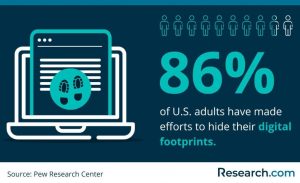
Source: Pew Research Center
In today’s digital age, our online presence, or digital footprint, is constantly evolving. Here are some key trends businesses need to be aware of in 2024:
Trend #1: Growing Privacy Concerns: Consumers are becoming increasingly conscious of how their data is collected, used, and shared online. This is fueled by high-profile data breaches and growing awareness of online tracking practices. Building trust with your customers is crucial. Transparency in data collection practices and strong privacy policies will become essential for attracting and retaining customers.
Trend #2: Rise of Reputation Management: With online reviews and social media influencing purchasing decisions, businesses are prioritizing managing their online reputation. This includes actively monitoring online mentions, responding to customer feedback, and proactively building positive brand sentiment. A positive online reputation can significantly impact your brand image and sales. Actively managing your reputation helps mitigate negative feedback and build trust with potential customers.
Trend #3: Data Ownership and Control: Regulations like GDPR (General Data Protection Regulation) and CCPA (California Consumer Privacy Act) are empowering users to have more control over their personal data. Users are demanding the ability to access, correct, and even delete their data. Understanding and complying with data privacy regulations is essential. Businesses need to ensure they are collecting and using data ethically and with user consent.
3 Tips for Managing Your Digital Footprint in 2024
In today’s data-driven world, managing your digital footprint is crucial for both individuals and businesses. Here are some key tips to stay on top of your online presence in 2024:
Tip #1: Regularly Review Your Online Presence: Just like cleaning out your physical closet, it’s important to declutter your digital footprint. Conduct periodic searches for your name and variations of it across search engines and social media platforms. Identify outdated or inappropriate content, such as old social media posts or forgotten online accounts. Consider deleting or deactivating these accounts to maintain a professional and curated online persona. This proactive approach helps ensure your online presence accurately reflects your current persona and career goals. Social intelligence tools can be valuable in this process, allowing you to track online mentions and identify areas that might require attention.
Tip #2: Use Privacy-Focused Tools: Many online tools and services collect user data for various purposes. To minimize the amount of data exposed, consider using privacy-focused alternatives. For example, opt for search engines that don’t track your searches or use email providers with strong encryption practices. Additionally, utilize privacy settings on social media platforms to control who can see your information and activity. By adopting these privacy-focused habits, you can take charge of your online data and minimize the risk of exposure. This aligns with the growing trend of user control over data, a key aspect of social intelligence marketing.
Tip #3: Post High-Quality Content: Curating a positive digital footprint extends beyond simply cleaning up your online presence. Actively shaping your online image by sharing valuable and engaging content establishes you as a thought leader in your field.
- Focus on Quality over Quantity: Prioritize creating insightful content that showcases your expertise and interests. Share articles, blog posts, infographics, or even videos that resonate with your target audience.
- Maintain Consistency: Regularly contributing to online conversations keeps your profile active and demonstrates your commitment to a specific niche.
- Engage with Others: Don’t just post and disappear. Respond to comments, participate in relevant discussions, and build connections with like-minded individuals.
By consistently sharing high-quality content and engaging with your online community, you actively build a positive digital footprint that reflects your expertise and fosters valuable connections. This approach aligns with social intelligence marketing principles by demonstrating thought leadership and fostering engagement, both crucial aspects of building a strong online brand.
Measuring the Impact of Digital Footprint in Marketing
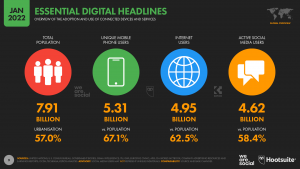
Source: ResearchGate
Just like tracking website traffic or campaign performance, understanding how your online presence resonates with your audience allows for continuous improvement. By analyzing your digital footprint, you can identify what content resonates, gauge brand sentiment, and ultimately optimize your marketing efforts for better results. Here are some key ways to measure the impact of your digital footprint:
- Website Traffic and Engagement: Track website visits, bounce rate, time spent on site, and page views to see if your online presence drives qualified traffic. High engagement metrics indicate your digital footprint is attracting the right audience.
- Social Media Analytics: Utilize built-in analytics tools on social media platforms to monitor metrics like follower growth, reach, engagement rates (likes, comments, shares), and click-through rates on links you share. This data reveals what content resonates with your audience and helps identify areas for improvement.
- Brand Mentions and Sentiment Analysis: Social listening tools can track online mentions of your brand across various platforms. Analyze the sentiment of these mentions (positive, negative, or neutral) to understand brand perception and identify potential customer concerns.
- Lead Generation and Conversions: Track how many leads you generate from your digital footprint, whether through website forms, social media interactions, or email signups. This helps measure how effectively your online presence converts potential customers.
- Search Engine Ranking and Visibility: Monitor your website’s ranking for relevant keywords to see if your content marketing efforts are improving organic search visibility. Higher ranking typically leads to increased website traffic and brand awareness.
By incorporating these measurement techniques, you can gain valuable insights into the effectiveness of your digital footprint and make data-driven decisions to optimize your marketing strategy for long-term success. This aligns with social intelligence marketing principles by leveraging data and analytics to understand your audience and refine your online presence for maximum impact.
Start integrating digital footprint into your marketing strategy today with Palowise
In today’s digital landscape, investing in your digital footprint is essential, with over 90% of consumers using digital platforms to discover businesses. With 58.4% of internet users making weekly online purchases, the frequency of consumer-brand interactions is on the rise, emphasizing the significance of a strong digital presence. Palowise specializes in optimizing digital footprints for companies, offering a comprehensive tool and expert team for tracking, analyzing, and enhancing online visibility.
With impressive KPIs showcasing Palowise’s expertise, including increased website traffic and improved search engine rankings, now is the time to integrate digital footprint strategies into your marketing approach.
Request a demo from Palowise today and propel your business towards digital success.


